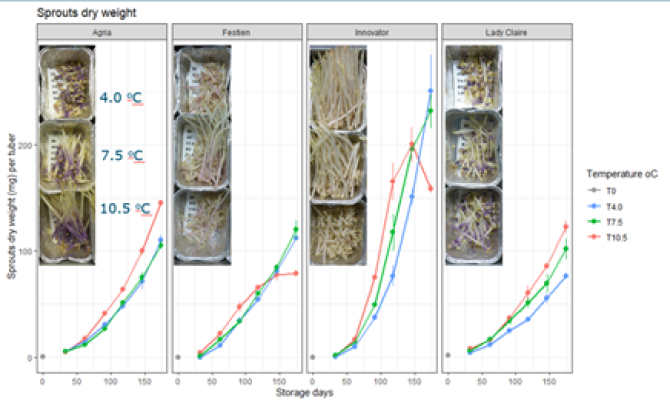
Project
On the assessment of physiological age of seed potatoes and the subsequent crop performance
A significant part of the potato yield gap is attributed to the sub-optimal physiological age of seed tubers. A lack of clarity on the physiological age hinders producers making a good planning of storage and planting, and contributed to poor crop establishment and yield. In this project we aim to develop reliable tools to assess physiological age by exploring potato metabolomics and using dynamic modelling to predict the tuber ageing process during storage and the subsequent crop performance.
Background
The current potato (Solanum tuberosum L.) production system relies mainly on vegetative propagation through seed tubers. The physiological quality of these tubers determines the potency for vigorous plant growth and good yield and is thus of high agronomic and socio-economic importance.
Physiological quality is characterised by dormancy and physiological age. Dormancy is the physiological state of the tuber in which sprout growth will not occur; physiological age is the physiological state of the tuber which influences its productive capacity. Physiological age affects the number of sprout-producing buds, sprouting behaviour, the number and vigour of stems per plant, the onset of tuber set, the number of tubers formed per stem and the duration of tuber bulking.
In practice, planting physiologically older seed tubers results in earlier canopy growth with a shorter growing period, and planting younger seed tubers results in slower canopy development with a longer growing period. The significance of physiological age on crop growth and yield has led to extensive studies, yet its intricate nature hinders clarification of environmental factors, biochemical cues, and the underlying biological mechanisms.
Project description
The physiological age of seed tubers is crucial for their growth vigour and the subsequent crop development and yield. Through complex processes and interacting factors, physiological age influences both above-ground and below-ground crop growth, reflecting the vitality of seed tubers. As a trait of high complexity, physiological age is influenced by genotype, seed tuber growth history, chronological age, and conditions and treatments during and after storage, and their interactions.
To study the development of physiological age of the seed and its impact on subsequent crop performance, in this research we use cultivars of contrasting maturity types and different rates of physiological ageing of seed tubers and store them at different temperatures. Sprouting behaviours of seed tubers are examined. Plant metabolomics is used to analyse changes in the metabolite profiles of cultivars in response to storage temperatures, and to look for potential biochemical indicators of physiological age.
Data collected is applied in modelling the development of physiological age during storage accounting for Genotype x Environment interaction. Seed tubers are planted at multiple experimental field sites. Data collected from field measurements are combined with sprouting and metabolic data to model the impact of physiological age on crop performance. Models developed during this project are evaluated and applied in improved decision support systems for crop management and to reduce the yield gap in potato production.
